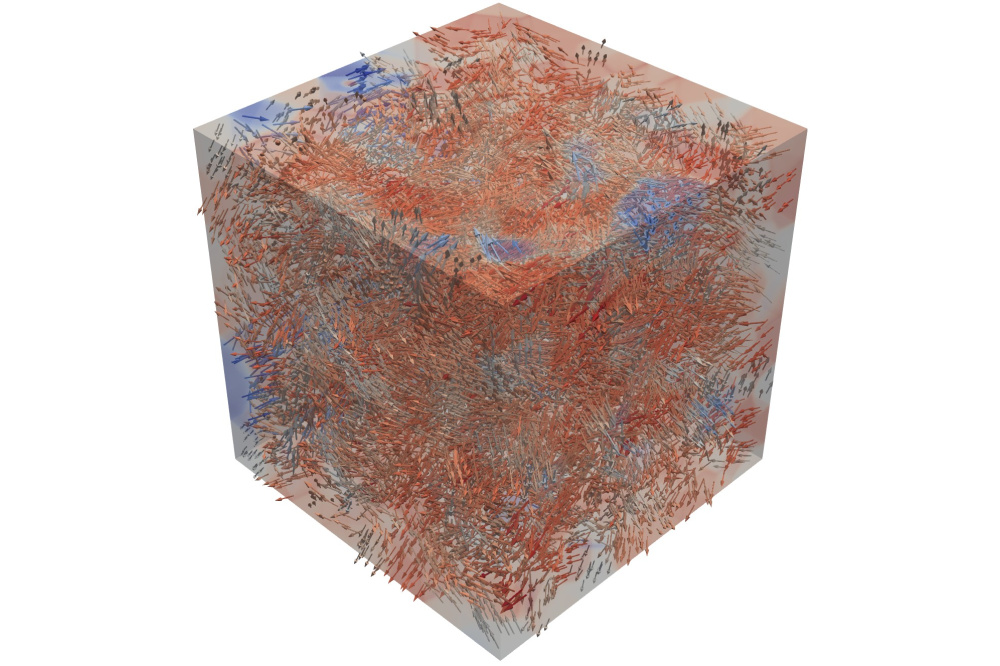Micromagnetic Modelling of Hard and Soft Magnetic Materials
Einleitung
Magnetic materials are essential for modern applications, ranging from renewable energy sources to e-mobility. Improving their performance requires understanding magnetization reversals under different conditions. Magnetic domain structures, the building blocks of magnetic materials, interact in complex ways influenced by composition, microstructure, and external factors, such as applied magnetic fields. Experimentally, direct observation of magnetic domains can be performed at macroscopic length scales, providing information about their motion. However, physical understanding cannot be obtained so straightforwardly because the lateral resolution is limited by the wavelengths of visible light. Another way to investigate the magnetic properties of materials experimentally is to measure their bulk magnetization response, which provides an overview of how the material responds to external stimuli. While both experiments provide information about magnetic properties, a complete understanding is not possible without micromagnetic simulations. Micromagnetic simulations allow us to create detailed virtual representations of magnetic materials and study their behavior in different scenarios. However, such simulations are computationally demanding because they generally consist of a few million regions in three-dimensional space. Because these simulations are computationally demanding, parallel processing is necessary to simulate realistic structures that resemble real-world samples. Realistic simulation models require solutions to dynamic differential equations, making high-performance computers (HPCs) essential. Without HPCs, these calculations would take weeks to months of GPU time per simulation, making exploration of the parameter spaces impossible for a proper explanation of the experimental findings.
Methoden
The project uses micromagnetic simulations to study how microstructures and external field parameters affect each other. Meshes are generated to represent the microstructural features of hard and soft magnetic materials. Different regions are defined to mimic polycrystalline or single-crystalline regions, and material parameters are assigned to each region. Simulations are then performed at each mesh point using the Landau–Lifshitz–Gilbert equation. Simulations were performed for various material properties, microstructural features, and external fields.
Ergebnisse
During the initial stage of the project, we conducted validation simulations in which we tested various microstructures and material parameters using the Mumax3 code. Later stages of the project used the Magnum.np code, which provides greater flexibility in material design and microstructural features. Micromagnetic simulations were performed on different materials to support the experimental work. A systematic scan of different shape anisotropies was carried out. Some micromagnetic simulation results obtained in this small project are included in a research paper that is being prepared for submission alongside the experimental findings.
Diskussion
The simulation results showed that the microstructural features of hard magnetic materials significantly impact their magnetic performance. Textbooks mention that the intrinsic property of magnetocrystalline anisotropy and the anisotropy field limit coercivity values. However, if proper shape anisotropy can be triggered in different material systems, it is possible to overcome coercivity values limited by Brown's paradox. The simulations carried out in this project provided insight into the ideal grain shapes for different materials, considering their intrinsic magnetic properties. Another useful application of micromagnetic simulations is in exchange-coupled magnetic systems, where two materials with different intrinsic magnetic properties interact. For the simulations, we replicated the microstructures observed with transmission electron microscopy. We then carried out micromagnetic simulations on these structures and compared the simulated magnetic responses with the bulk magnetization results. We obtained good agreement between the simulations and the experimental results.




